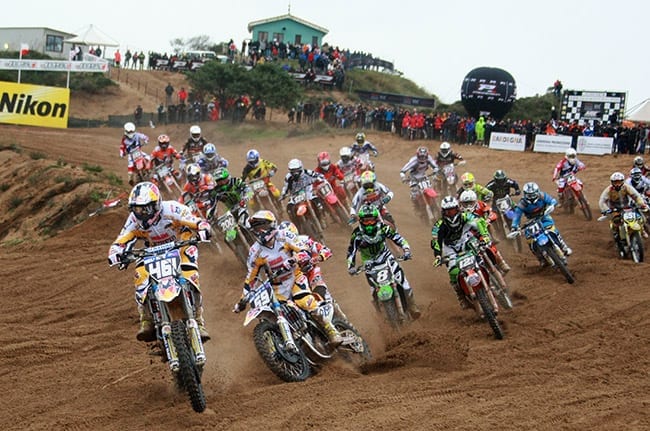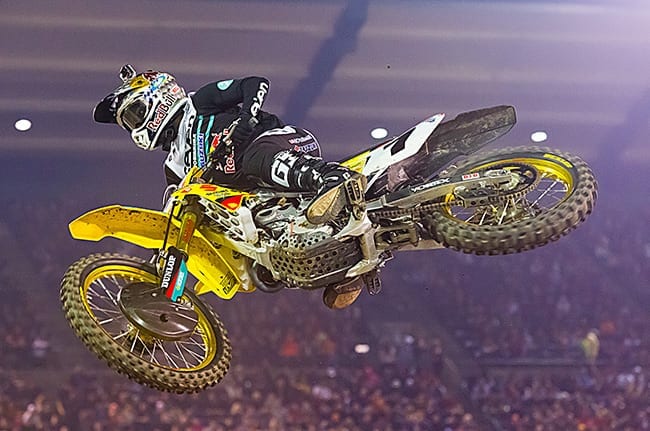GP Circus is back in town
By TMX Archives on 20th Feb 14

On Friday next week (March 1) the GP wheels will be spinning for the first time this year under the lights in Qatar.But is it really the beginning of a new era?
Of course not, the name may have changed, but the actors are still the same, even if some of the court jesters have a new costume for 2014.
And nothing is ever completely new in heaven or on earth. The very first year of the unequal battle between 250cc strokers and 450cc thumpers under Dorna in 2003 already ran under the title ‘MXGP'.
So what is new?
The race format in Qatar, Thailand and Brazil for starters.
This time last year the Superfinal, with the top 20 riders from each class to combat the rider shortage overseas, was being presented as the all-singing, all-dancing future of the sport at every round from 2014.
But by mid-summer the experiment had failed dismally, panic cosmetic changes making matters even worse, and the two-moto format was confirmed.
Nothing new, this had been the norm since 1960 barring the made for TV three-moto format in the early 1990s and Dorna's potential death knell single moto format from 2001-03.
But there is change. Long gone is the once mystical 40-minutes plus two-laps (though ‘traditionalists' should note that this wasn't introduced until the late 1970s), and the return to two motos in 2004 had been raced as ‘35+2-laps'.
Ten years on we lose another five-minutes and the motos will be just ‘30+2-laps'. If you waste your breath asking why, you will get a load of flannel about ‘world standardisation' or ‘more intense racing'.
You want to know the truth? A 30+2-laps format fits better into the one-hour TV schedule, with riding out over the ramp between sweet-smiling Grace and Sophia onto the sighting lap, idiotic questions at the gate, post-race corporate debriefing and the sterile podium with all of the local dignitaries enjoying their ten seconds of fame.
Oh, and the adverts.
Indeed the visual media, whether it be Youthstream's very own online MXGP-TV, or Pay TV who need action to relieve the boredom of football, tennis or F1, has been the ever-growing nucleus of all regulation change for two decades.
That Superfinal idea was ‘made for TV' to sell a one-hour show to the uninitiated, but big business has long since gone 24/7 with multiple channels so there are slots aplenty, even if they are at 3am, to show every race.
And you have a recorder with a timer, right? Now all they have to do is to respect their own schedules.
The sad fact is that even if travel costs and admission fees had not gone through the roof, the hordes who would travel Europe at breakneck speed to watch their favourite sport trackside was an 1980 and 1990s phenomenon, and the modern generation want everything served up on a silver platter with everything at the swipe of an index finger.
Sad of course, but they are the target of the energy drinks firms who have long replaced the socially unacceptable tobacco giants in financing the chosen few who actually make money out of the sport.
We should not be too ungrateful, after all just how many minutes of Dave Thorpe's hat-trick of titles were ever shown on terrestial UK TV?
And some of the technical advances – drones, helmet cams, etc – are a genuine enrichment.
There are downsides, but give ‘Maler' (commentator Paul Malin) a break, he may drone on at times, but you try talking non-stop for six hours, and at least he knows what the sport's about.
Co-commentators and the studio chats want to make you throw up? You can always turn down the volume, and use the longer breaks to go and make a fresh pot of tea.
Motocross is still light years behind F1, MXGP, darts, pingpong, snooker and tennis when it comes to travelling the globe, but the trend is inevitable in a world with new markets to be targeted by potential sponsors.
And Giuseppe Luongo (GL) is no different to Bernie (Ecclestone) in knowing where his new ‘friends' (aka financiers) are based... and they are not in the dwindling economies of Western Europe.
MXGP goes overseas for five races out of the 18-race schedule, which will be a new record if they all run.
The development brings with it inconvenience for the teams, as the season now extends from the first weekend of March to the end of September.
But the expanded time span does allow occasional weeks to regroup through mid-summer and delays the first races in northern climes to May.
The first gripes over the number of bikes at the gate have already been uttered, but let's put the situation into perspective.
Forty riders on the gate did NOT come in with the Ark.
Prior to 1982 there was no standard, indeed many GPs in the 1950s, played out before massive enthusiastic crowds, had a round dozen top men at the start, and 25-30 was the norm rather than the exception in the 1960s and 1970s.
For 2014 Mr Luongo has capped the MXGP field at 30, with ten more allowed in MX – and quite frankly larger numbers would simply be tourists getting in the way within 15 minutes.
Never mind the width, feel the quality in MXGP. There are no noddies in the 25 riders who will go to the gate in Qatar next weekend, and no less than 14 of them are genuine factory riders.
Never before has there been so much true factory commitment, and that pays dividends for the onlooker.
Many fans from the heyday of trackside support, generated in UK terms by Noyce, Hudson, Thorpe, Nicoll, Whatley and Herring, have a rose-tinted view of their youth, and the fact is that those in the second rank kept their head above water by grafting at international races, with an annual schedule of 40-50 races, as many as five at Easter, midweek Bank Holidays abroad, racing Saturday AND Sunday.
And those who made up the numbers at the back were already sponsored by the sport's number one backers – mum and dad – even then.
After all it was better than getting a job.
Another change this year will see the race day programme in Europe put back by an hour with the second MXGP moto starting just after 5pm.
Ironic really that the move comes after trackside fans had got come to terms with a noon kick-off for the main programme, and it probably puts more pressure on getting away quickly to be home for work on Monday morning.
But at least the sport is moving back from those ghastly days when the GP racing at 11am.
The most significant development of recent years has been the MX2 age-capping device to push the ‘named riders' into MXGP.
It is fair comment that some slightly-built riders – three-times 125cc world champ ‘Chicco' Chiodi was the perfect example – simply couldn't display their skills to the full on a bigger bike.
But, maintaining the Italian connection, 1999 500 world champ Andrea Bartolini – the first four-stroke champion on a Japanese bike – was little bigger than Chicco. For many the ‘excuse' was an easy way out.
An analysis of the 25 permanent MXGP starters for 2014 illustrates the success of the age-cap admirably.
No less than 15 of them were MX2 GP regulars in 2008 – Rattray, Searle, Simpson, Goncalves, Cairoli, Boog, Van Horebeek, Frossard, Roelants, Guarneri, Paulin, Bobryshev, Nicholls, Karro and Brakke.
And who has fallen by the wayside? Of the top ten that year only Nico Aubin and the retired Stephen Sword.
Just six of the current crop – Desalle, De Dycker, Strijbos, Nagl, Philippaerts and Leok – were racing MX1 in 2008.
Note that ALL of them bar ‘DP19' are still full factory riders, and the 2008 champ gets full technical support from Rinaldi.
Making up the numbers are the very last MX3 champ Klemen Gercar, exciting Belgian hopeful Jens Getteman, Augusts Justs with Latvian state aid, and newcomer Todd Waters on the factory Husqvarna.
The age-cap brings with it yet another ‘bonus' for the onlookers.
No less than seven top runners from MX2 are available to move up to MXGP in 2015.
Six of them MUST move or quit, and the powers-that-be in Mattighofen decided long ago that this will be the final year of Jeffrey Herlings' MX2 career.
With no sign of additional team places on the horizon, the pressure on anyone from sixth place down in MXGP will be intense.
Anyone who fails to deliver can pack his bags, and the on-track action will be vivid for every place right to the chequered flag.
The days of riding home for a 12th place are gone.
The same applies of course to the MX2 brigade looking for a ride on a 450.
They may not be a danger to Herlings, though of course this would be a bonus, but each of them – Lupino, Butron, Coldenhoff, Tonus, Charlier and Febvre – has to perform to present his credentials for a ride, because the only certainty is that Herlings will pilot a third factory MXGP KTM under the eagle eye of Stefan Everts.
It is probably true to say that some of the sextet would be unlikely to outrun the riders they will replace, but, as Michele Rinaldi ruefully admitted as we chatted on Sardinia recently: "Sixth place brings us nothing.
"The next generation may not be able to offer us more, but we have to take a chance that they could be the next front runner, because the guys who continue to run 6-15 year after a year in MXGP are not.”
It is a hard truth from a man who quit his racing career in his mid-20s (of his own choice) to pursue his career in management, after finishing fourth in the world.
Incidentally next for the compulsory step up from MX2 to MXGP are:
2016 – Kullas, Pocock, Tixier, Guillod
2017 – Anstie, Tonkov, Desprey
2018 – Ferrandis, Leiber, Petrov, Seewer (and in theory Herlings)
2020 – Gajser
2021 – Jonass
At the other end of the scale, the old boy of MXGP is David Philippaerts, who was 30 last December.
A side note to put hard reality into perspective, but prove that age is not a limit in itself – Chad Reed will be 32 next month.
The 2014 season marks the return of the entire WMX series to the big time for the first time since it was banished to MX3 four years ago. Has ‘GL' had a change of heart? Not really. With MX3 securely in the trash can, there really was little option.
The diplomatic appearance of equality meant that WMX was never in danger of the chop, and where else could it go?
The move heralds the return of Livi Lancelot and Larissa Papenmeier to the series to complete the elite with champion Chiara Fontanesi, Meghan Rutledge, Steffi Laier and Nat Kane plus the expected advance of Nancy Van de Ven after her thrilling rookie year on a 125.
But it remains doubtful that the series will attract much more public awareness when the motos run at 7pm on Saturday and 10am Sunday morning.
Of the other support classes the European 125cc series has its attractions for the two-stroke fans, and the podium regulars are inevitably the future of the sport.
EMX2 is the most important, directly providing the next crop of MX2 GP runners, the lure of a title ensuring that lads who could probably already race for tenth in the GP will dominate the podiums.
Sevlievo at Easter will give us the first indication of who is hot, but the season opener on Sardinia already suggests that the kid to beat will be Pauls Jonass.
The 17-year-old Latvian is being shipped out to the overseas GPs to work on his speed aboard a 250F, but already in Sardinia three weeks ago he was running with world No.2 Jordi Tixier. All part of the KTM talent programme.
Completing the day are the Honda 150F Cup and the new Euro 300 series.
TMX will be there each week to bring you the real story and the inside news.


